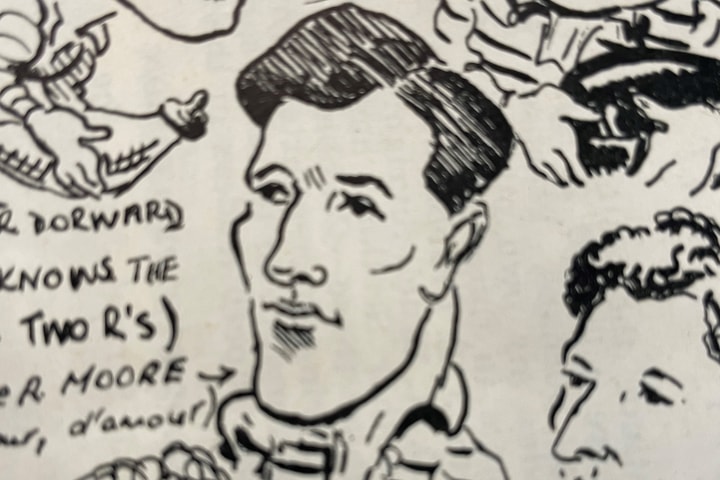
21 November 2025

William Ernest Crawford (1891-1959)
The Irish selectors alighted on the Lansdowne and Leinster player William Ernest 'Ernie' Crawford as their full back when they chose the team for the first post-war Ireland international against England at Lansdowne Road, Dublin on February 14th 1920.

Ernie Crawford had endured a long wait for his first international rugby cap at the age of twenty eight. Born in Belfast on November 17th 1891 and educated at Methodist College, he had played for Malone and Ulster from 1910 until the outbreak of the First World War. He was captain of Malone for the 1912-13 and 1913-14 seasons and played for Ulster against the touring South Africa side in December 1912.
He joined the 6th Inniskilling Dragoons as a Staff Quarter Master Serjeant in autumn 1914, served subsequently in the Ulster Division and was commissioned as a second lieutenant in the 18th London Irish Regiment later in the war. He was wounded in the wrist at the Battle of Arras in April/May 1917 and discharged from the army with a permanent disability. He had lost manual facility in three of his fingers, a remarkable disability for a player who was to become one of Ireland's longest-serving full backs.
He was on the staff of the Ministry of Munitions at the end of the war after which he moved to Dublin to work as a chartered accountant with Rathmines Urban Council. He quickly enhanced his reputation as an outstanding sportsman, both as a rugby player with Lansdowne and Leinster and as a footballer with Bohemians and a member of the Irish national football squad for the 1924 Olympic Games in Paris.
His selection as Ireland's rugby full back following the Final Trial in January 1920 was not unanimously endorsed by the national newspapers, but the Belfast News-Letter said that:
"There was very little doubt in followers of the game that Crawford would be selected for the full back position. He was not seen at his best on Saturday, but he is on the whole a very consistent player; he tackles well, kicks a good length, and is cool when hard pressed".
There were eleven new caps in the side to face England, and Ireland succumbed to a 14-11 defeat after leading 11-0 shortly after half-time. Although the team was criticised in the newspapers after the match, the Irish Independent was complimentary about Crawford's performance saying that:
"He fairly rose to the occasion and his display was one of the redeeming features of the Irish side".
Crawford survived the cull by the selectors when six more new caps were picked for the match against Scotland at Inverleith later that month where Ireland suffered a humiliating 19-0 defeat. Three more new caps were then chosen for the visit to Cardiff to face Wales, but once again Ireland was heavily beaten by 28 points to 4. For the final match of the season in April against France at Lansdowne Road, three more new caps were chosen but the Ireland team was defeated for the first time by France 15-7 to take the mythical wooden spoon.
Twenty three new players were picked for Ireland in four internationals in 1920 but only three of them survived the season. One of them was Ernie Crawford, the only back to play in all four matches, and he had been the undoubted find of the season. Although missing the occasional match from then onwards, he was to be Ireland's first choice at full back until the end of the 1927 season winning an Irish equalling record of 30 caps and captaining Ireland on 15 occasions.
Seldom the first-choice kicker, a role taken most often by the centre and wing George Stephenson who also made his international debut in 1920 and went on to win 42 caps, Crawford scored 18 points from 6 conversions and two penalty goals in his long career. Although his overall record consisted of 12 wins, 1 draw and 17 defeats, his record as an inspirational captain was far superior in that his Irish side was only defeated in four of his fifteen internationals as captain.
Captain of Lansdowne RFC for two seasons from 1921 to 1923, he played for the combined Ireland-Scotland team against England-Wales in the William Webb Ellis Centenary match at Rugby School in November 1923 and for Ulster and Ireland in two matches against the touring All Blacks in 1924. He went on six Easter tours of South Wales with the Barbarians for whom he played 12 matches and was a committee member for over twenty years. A colourful character hugely respected by his fellow players and feared by his opponents, the great English forward Wavell Wakefield described him as:
"a kind of brooding intelligence, directing the play, crouching and waiting like a spider for the unfortunate man who has to try to pass him".

Combined Ireland-Scotland team, 1923
After his rugby career ended, he remained heavily involved in rugby as an Ireland selector from 1943 to 1951; President of Ulster in 1944-46; President of Malone RFC in 1947-48; and President of the Irish Rugby Football Union in 1957-58.
He qualified as a barrister in 1924 and returned to Belfast and was City Treasurer of Belfast from 1933 to his retirement in 1954. Married with three children, he died in Belfast on January 11th 1959.
Sources:
About the Author - A professional musician and arts administrator, Richard Steele has had a life-long love of sport. He has been on the committee of the World Rugby Museum at Twickenham since 2005.
Visit our website, book your visit and follow us on Facebook, Twitter and Instagram.